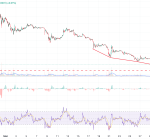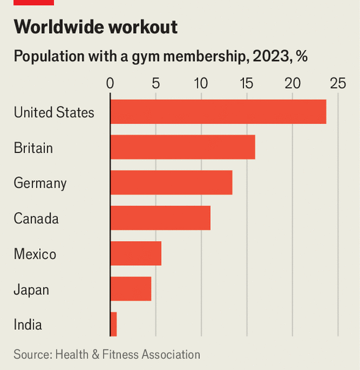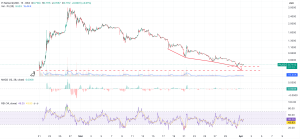In May Equinox, a luxury gym, launched a membership that costs $40,000 per year—half the median household income in America, where the chain is based. The plan includes blood tests, a sleep coach and a nutritionist, as well as access to the group’s swanky clubs. Julia Klim of Equinox explains why people pay: “You can buy a Chanel bag every year, but health and looking well is the ultimate luxury symbol.”
Analysts proclaimed the death of the gym during the covid-19 pandemic, when fitness centres shut and people got used to online workouts with a towel in place of a yoga mat and a couple of bottles of pinot noir for weights. Customers signed up for at-home alternatives such as Peloton, a maker of high-tech exercise bikes, which hit a value of almost $50bn in January 2021.
But since March 2021 footfall at gyms across America has been growing, according to Placer.ai, a location-analytics firm. The global market for physical activity, including everything from apparel to equipment, will grow by 8% a year in 2023-27, forecasts the Global Wellness Institute, a non-profit group. Peloton’s value has fallen by 96%. As Fritz Lanman, head of Classpass, an exercise subscription firm, puts it: “There is nothing that replicates that in-person experience yet.”

Industry watchers have spotted a “barbell effect”, where mid-range gyms are losing out. PwC, a consultancy, says the budget segment has doubled its share of Britain’s fitness industry in the past decade, to almost a fifth of the private market. Will Orr, head of the Gym Group, a low-cost chain, compares gyms to airlines: “People buy into that no-frills proposition,” he says.
The rich still want frills, however, so luxury gyms are also thriving. The pandemic got wealthy folk worrying about their health; wearable devices now tell them how well they sleep or respond to sugar, creating new nudges to work out. In a survey by Mindbody, which makes fitness software, in 2021 most Americans said they exercised to control weight. In 2023 most said it was to live a long, healthy life.
The buzzword in the industry is “wellness”. Third Space, a high-end gym group in London, is installing cold plunges, cryotherapy chambers and red-light therapy rooms. “Five years ago if you asked someone why they used the sauna they would have said, ‘It feels quite nice’,” says its boss, Colin Waggett. Now they talk about “recovery, sleep and mental well-being”.
Gyms now face a test. A new generation of slimming drugs such as semaglutide are selling fast. Bloomberg, a data provider, reckons worldwide sales will reach $94bn in 2030. Why sweat away in the gym? Mr Waggett argues that slimming drugs can cause users to lose muscle as well as fat; shedding weight also inspires people to tone up, he believes: “It gives them a catalyst for change.”
There is another reason to hit the gym. As youngsters battle loneliness, gyms are hosting socials. At Equinox, Friday evenings are a new peak time. “The gym is the new happy hour, the new dating place, the new connector,” says Ms Klim. Would a $40,000 membership be worth it if you left the gym fitter, calmer—and with a date?■
To stay on top of the biggest stories in business and technology, sign up to the Bottom Line, our weekly subscriber-only newsletter.

















